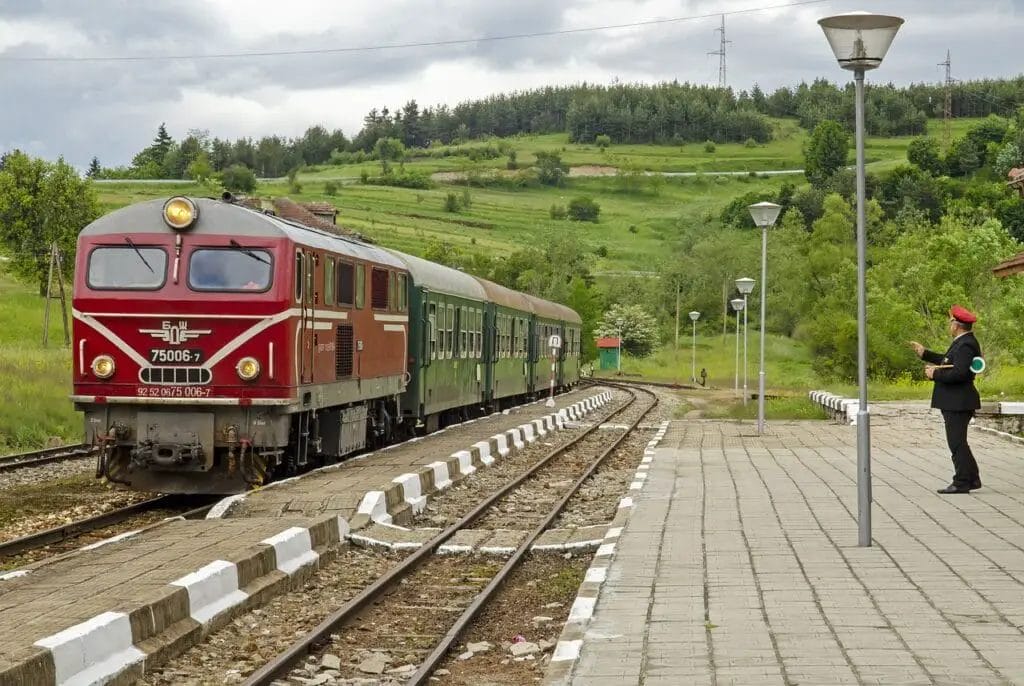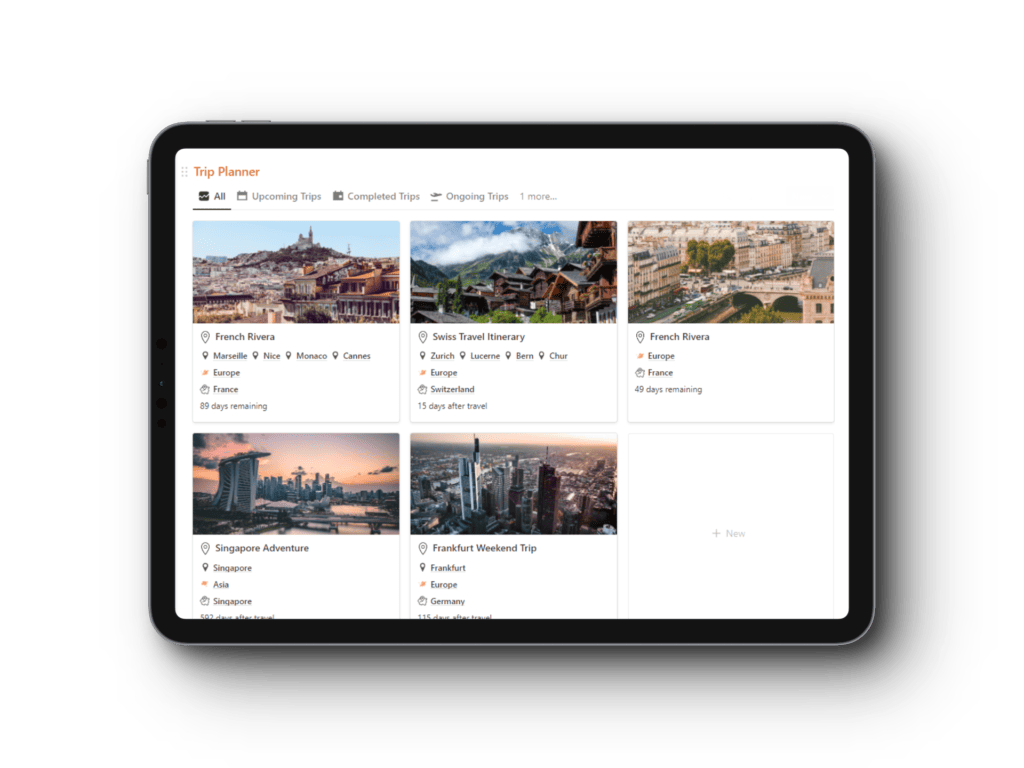Complete Guide for Train Travel in Europe
Train travel is the best way to see Europe. It’s romantic. It’s inspiring. It’s super-efficient. It’s comfortable. It’s almost magical, some might even say. It’s also a bit mysterious to those who don’t live where train travel is a common feature.
This Complete Guide to Train Travel in Europe will cover all aspects of rail travel throughout Europe. It includes how to check train schedules, get rail passes, ride trains, navigate train stations, and other details. You’ll be an expert on European trains by the time you finish this guide!
Quick Tip: Train tickets in Europe are electronic now so you will need reliable and fast mobile data when travelling by train. You can find my guide on how to use your phone to travel in Europe as well as our guide to the best SIM cards and data plans for Europe.

Europe Train Travel: The Good and the Bad
Let’s begin by giving you a brief overview of the positive and negative aspects of European train travel.
Benefits of Train Travel in Europe
- You can find the center of town
- European train stations can be found right in the centre of town, unlike airports. Because you are already in the city, you don’t need to spend money or time travelling there. Travelling from the airport into the city takes anywhere between 20-60 minutes, and costs between $10 and $80.
- Check-in and security lines are eliminated
- Most train travel does not require lengthy security screening or check-in. Simply show up at the station a few minutes prior to the departure of the train, purchase a ticket (often from an automated ticket machine with English instructions), then board the train.
- No Luggage Limits/Fees
- Multiple pieces of luggage are allowed without additional fees or weight restrictions. You should ensure that your bag can be lifted onto the train.
- E-Tickets
- Many rail companies now offer electronic tickets. These tickets can be sent right to your phone. This eliminates the need to wait in line for tickets and makes it much easier to plan your train travel. Although e-tickets are not yet available in every country, they are becoming more popular each year.
- Take a Picnic (Don’t Forget the Wine and Beer).
- It’s possible to bring almost anything on a train, even alcohol. If you share a few with your fellow travelers, you’re bound to make some new friends. Stop by your local grocery store to pick up food and snacks for your journey.
- Multiple Trains and a vast rail network
- The rail network in Europe is vast, so even small towns can be reached by train. Many destinations have multiple trains per day. It is not difficult to get to the most popular destinations by taking a train every hour.
- Take a train ride to sleep on the train and extend your travel time
- Consider taking an overnight train if you are traveling long distances. These special sleeper cars have bunk rooms with either six or two beds. While a bunk in a sleeper vehicle will cost you $35-$65 more than a night in hostel, it won’t mean that you are missing out on a full day of travel. You can also get normal seats on overnight trains, but they are a bit more expensive.
- Spontaneous Travel
- You can travel by train and you can be spontaneous. Simply show up at any station and buy a ticket.
- Beautiful Views
- Europe is home to many beautiful landscapes, so it’s a great place to travel by train.
- Peace and Quiet
- Relaxing on the train is a great way to unwind. It is very relaxing to gaze out of the window and ride at 170 MPH through Europe’s countryside. You can also use the train to send a message to friends or to read a book. Or, you can write in your journal.
- If you really want to relax, some trains offer quiet cars.
- Relaxing on the train is a great way to unwind. It is very relaxing to gaze out of the window and ride at 170 MPH through Europe’s countryside. You can also use the train to send a message to friends or to read a book. Or, you can write in your journal.
- Comfort
- Train seats are often larger and more comfortable than planes, especially when compared with many discount airlines. The train can be moved around as you wish. There are many trains that have seats facing each other with a table between them. These seats are great for groups and if you like the space. The train is rarely crowded, so you may be able get two seats if you are not on holiday or on a popular route.
- Reliable and on-time
- European trains run on time for well over 90% of their journeys, but flights only fly around 65%.
- Beautiful Train Stations
- Train stations have been the hub of commerce and transport for centuries. Grandiose train stations were a way for European cities to show off their wealth and status. It’s not a big deal but it’s one of those little perks.
- Specials for Youth
- Numerous countries offer substantial discounts to people younger than 26 years old, so make sure you check out those discounts.
- The train is fun
- It’s always been a fun experience to ride the train. It’s strangely relaxing and magical.
The disadvantages of train travel in Europe
- The Cost
- High-speed trains can make train travel expensive. Flying can be even cheaper because of the abundance of super-cheap flights across Europe.
- However, it is possible to get great deals if high-speed trains are booked in advance. You’ll be charged a premium for booking super late.
- There are also discounts available for those under 26 years old.
- Long-Distance Travel: Slow and slow
- High-speed trains travel at speeds of 150-180 MPH, but long distances can still take a lot of time. Some long-distance routes may require slower regional trains.
- Flying may be more practical if you are travelling over long distances. It would take approximately 15 hours to travel by train from Paris to Budapest, but it would only take 2.5 hours to fly. Flying would also be significantly cheaper.
- Notice: Add two to three hours travel time from/to the airport to your trip.
- Etwas Confusing
- Train schedules can be confusing, especially for beginners. There are many apps available that make it easier, but sometimes we get lost.
- Many large cities, as well as small towns, have multiple train stations (Paris has six!). It is not unusual to leave one station but arrive at another. There have been many instances when we arrived at the wrong station. Make sure to read your tickets.
- You can also change stations on a single trip. You can change stations on a single journey, such as when you travel from London to Lyon via the Eurostar. However, the Eurostar stops at Paris North station. Then, you will need to travel to Paris East station to catch the train to Paris from Lyon. There are no direct trains between London and Lyon. To transfer to this station, you will need to take a Metro (subway) ride.
- Rail Strikes
- Striking is a European national pastime. Striking happens only a few times per year, if people are not happy it can happen more often. However, they notify the strikers well in advance so it shouldn’t surprise anyone (just a hassle). They will just happen, so you’ll have to deal with it.
Pre-Trip Planning Tools
You will find many great websites to help you plan your train trip.
The first is Rome2Rio. Simply enter your destination and it will show you all available train routes, as well as bus and plane routes, for your trip. The interface of Rome2Rio is visually stunning. It gives you estimated travel times and costs, making it a great tool for comparing transport options. While you can book tickets via Rome2Rio, we found better prices for tickets on Omio or Trainline.
German Railways Website ( Bahn.de), displays the schedule for every train in Europe (yes every Train). It’s useful for putting together complicated train journeys. It’s useful for identifying which trains need reservations and other information. You cannot book German train tickets online.
To help you understand the peculiarities of each country’s railway network, we have also created a few country-specific guides.
How To Buy European Train Tickets
Automated train ticket machines are in English
It can be difficult to buy train tickets in Europe, especially if you are looking for the best deal.
Because each country has its own National railway service, and each does things differently, this is why it’s so. We’ll help you navigate the process.
Understanding the Pricing of Tickets
Before we begin, let’s explain the two main pricing methods for train tickets: fixed price and variable.
Variable-Price Fares
Variable fare prices can change based on the demand, day of week, year and distance from departure date. This pricing model is used by all high-speed trains.
- Pre-booking your high-speed train tickets in advance is a good idea to get the best prices. Usually, it takes a few weeks. The prices will increase as the departure date nears. You’ll be paying a lot if you wait.
- Of course, you lose flexibility if you have to buy tickets in advance because the cheapest tickets are normally non-refundable/unchangeable
Fixed-Price Fares
Fixed Fares are based on the distance covered. This is more common for slower and regional trains. This type of ticket doesn’t care when you buy them, as the price will never change.
Where to Buy Europe Train Tickets
You can buy European train tickets in two ways: directly at each country’s National Rail Service, either at the station or via a third-party search engine.
Third-Party Booking Websites
Third-party booking websites offer a number of advantages for purchasing train tickets.
- Booking complex or multi-country routes
- The advantage of booking with a third-party booking site is that it lets you book more complex multi-country/international train routes. Booking international routes is a problem for many National Rail Services (e.g. Many National Rail Services have trouble booking international routes (e.g., France to Italy). They don’t always offer the best deals and may not be able to show all possible routes.
- There are no credit card processing issues
- Unfortunately, many European National Rail websites have problems processing foreign credit cards. This is why it’s not uncommon for credit cards to be declined at bookings. These issues will not be present on third-party websites.
- There are no translation or technical issues.
- It’s not uncommon for Europe’s National Rail websites with technical issues and poor user interfaces to be hampered by these problems. During the booking process, you will often be switched from the English page to the local one. These issues are taken care of by third-party booking sites.
These are our Favorite Train Booking Sites
- Omio: Omio, a great train booking engine, allows you to book tickets from almost every country’s railway service. They also make it very easy to use the booking process.
- Trainline.com: TrainLine, a brand new European train booking site (very similar to Omio), sells train tickets from Austrian and German Railways Railways, as well as other countries.
National Booking Sites
Sometimes, despite technical difficulties, the cheapest tickets are only available if you book directly with each country’s national rail service. Sometimes they offer special deals that third-party booking websites don’t have access. It’s worth taking a moment to look at them.
Links to Some National Railway Sites:
Austrian Railways
Belgian Railways
Danish Railways
Finnish Railways
German Railways
Irish Railways
Italian Railways
Spanish Railways
Italian Railways
Spanish Railways
Netherlands Railways
Norwegian Railways
Polish Railways
Swedish Railways
United Kingdom Railways
Domestic tickets (i.e. 1 Domestic tickets (i.e., trips within the country) are the same price regardless of when they are purchased and do not require reservations. It is therefore easier to purchase tickets at the station.
These countries may have an international high-speed train system. For example, Belgium has slow regional trains and Thalys trains linking major Belgian cities with other international cities. It is best to buy these tickets early so you can get cheaper fares em>
A Quick Note on Eastern Europe Trains
Online ticket booking is not available in some Eastern European countries. Tickets can only be purchased at the station or through local travel agents. Ask the staff at your hotel or hostel to help you find an agent.
Receive your online tickets
After you have purchased your tickets, there are many ways to collect them.
- Electronic Tickets You can get an electronic ticket to your smartphone or tablet many times. Show the conductor at the station when he checks your tickets. This service is not available in all countries.
- Print-At–Home Tickets: Most places that offer electronic tickets will allow you to print your tickets at home. The PDF can be saved to your smartphone/tablet so that the conductor can scan it.
- Pick up at Station: You can print your tickets at ticket machines in train stations using your booking number or credit card. Notice: Often, you will need to use the same credit card to purchase tickets and collect them at the station.
Buy Tickets at The Station
Train tickets can be purchased at any station — either at the ticket window or more often, from automated ticket machines. The automated ticket machines are a better option than the long lines at the ticket windows, which can be slow and inefficient.
How to Buy Train Tickets at the Best Price
Most local and regional trains have fixed fares, so it is not a good idea to purchase them too early.
To get the lowest prices on high speed trains, you should buy your tickets as soon as possible. Most train tickets can usually be bought between 60 and 90 days before departure, but it is fine to buy tickets a few weeks in advance.
Let’s take a look at some examples of ticket prices:
- Paris to Nice
- 2 Days before departure: EUR69.00
- 3 Weeks before departure: EUR55
- Paris to Amsterdam
- Buy Two Days Prior to Departure: EUR135
- 3 Weeks before departure: EUR97
- Purchased 6 Weeks Prior to Departure: EUR54
- London to Paris (Eurostar Train
- 2 Days before departure: EUR234
- Purchased 3 Weeks before departure: 124
- Six weeks before departure: EUR55
You can save quite some money by booking a few weeks in advance, as you can see.
A Quick Note About Buying Train Tickets in Early
As stated above, buying tickets in advance is the best way to save money but this also limits your ability to be flexible/spontaneous. This is especially true because many train tickets that are really cheap are non-refundable. A rail pass will give you maximum flexibility. Our Guide to Using Rail Passes In Europe as well as our Eurail Pass Review are available here.
Additional Train Ticket Discounts
Many rail services offer discounts – some discounts are based upon rider age, while others are based in part on the region or the day of week.
- Youth Discount
- A youth discount is the most popular discount. This discount is typically for those under 27 years old.
- Discounts based on country
- Many countries offer discounts. For example, Germany has a Schones-Wochenende-Ticket (Happy Weekend Ticket) where groups of 2-5 people can ride as much as they want on regional trains from Saturday-Sunday for EUR44. To find out if discounts are available, check the rail service websites of each country.
Eurail Passes
Rail passes are preferred by many travelers over buying individual tickets. Eurail passes are a great option because they can help you travel more easily and save money depending on how you use them.
Note: We have written many articles about Eurail Passes. For more information, see our Guide to Using Rail Passes In Europe and our Eurail Pass Review.
A Quick Overview of Rail Passes
A rail pass (also Eurail Pass is a single ticket that allows you to ride any train throughout Europe. Simply hop on and show the conductor your pass. Although it is not as simple as it used to be, you can still ride any train in Europe without purchasing individual tickets.
Different types of rail passes
- Global Pass
- Continuous: Unrestricted travel to any Eurail country between 15 and 3 months.
- Flexi 10 to 15 travel days to any Eurail country (doesn’t have to be consecutive) within a two month period.
- Select Pass
- You can travel between 5 to 15 days within a two-month time period. However, you are limited to visiting 3, 4 or 5 bordering countries. If you have a list of countries that you are interested in visiting, these passes can be useful.
- One pass could include 10 days of train travel between France and Italy. Your 8 travel days are available for use within a two month period. You can travel by train every day, but only one travel day per day.
- You can travel between 5 to 15 days within a two-month time period. However, you are limited to visiting 3, 4 or 5 bordering countries. If you have a list of countries that you are interested in visiting, these passes can be useful.
- Single-Country Pass:
- You can only use eight days of travel in one country, but you must do it within a month.
Rail Passes: The Advantages
- Flexibility The greatest benefit of rail passes are their flexibility. All you have to do is walk on the train and go. This is why it’s a great option if you don’t like to plan or would prefer to wander around Europe.
- Long Distance Trains:A rail pass is a great way to save money if you are planning on traveling long distances. However, single tickets are better if you plan to take a lot of short trains rides.
- Low stress:Piecing together multiple train journeys and then purchasing individual tickets can be stressful. It also takes a lot time and planning. A lot of people find that paying a little more for a rail pass is well worth the time saved by being able to plan your entire trip in advance.
Rail Passes: The disadvantages
- Expensive: It is usually cheaper to buy your train tickets online several weeks ahead of time. However, these pre-purchased cheap tickets are usually non-refundable and you will lose most of the flexibility. A rail pass is much more affordable if you purchase your train tickets several days in advance of departure.
- Reservations Some countries require that rail pass holders pay an additional fee to reserve a high-speed train seat. They can be paid in advance, online or at the station. The fees can be anywhere from EUR5 to EUR35. This guide will explain rail pass reservations. You can also enter your journey into Bahn.de to see if it requires a reservation.
At The Train Station
It is possible to get lost at train stations
Okay, we now know all about rail passes and buying tickets for trains. Let’s find out what you can expect at the station.
Train stations are the major transportation hub for most European cities. It can be confusing and chaotic, especially if you’re new to train travel. We’ll share some tips with you to help you locate your train.
Navigating the Train Station
Because many cities have multiple stations, it is important to ensure you have the right station. Paris, for example, has six stations while smaller towns may have two stations.
You’ll find English signage once you get to the station. You may need to walk a lot and use escalators and stairs at some stations.
Depending on how big the station is, there will be food trucks, shops, cafés, coffee shops, lounges and toilets. However, sometimes you have to pay for them. We often pick up a drink and a snack to take with us on the train. You can also rent luggage lockers at most train stations.
Scams and pickpockets
Train stations can be very busy and chaotic, with many confused tourists, so they are a popular target for pickpockets or other scammers. Be careful with your belongings and avoid “helpful” strangers who offer to assist you at the ticket machines. Our Guide to Avoiding Pickpockets in Europe.
Machines for Ticket Sales
Tickets are easy to get with automated ticket machines
You can use the automated ticket machines to purchase your train tickets and print your purchased tickets. The machines are simple to use and everything is in English.
Alternativly, you can also go to the ticket window/customer service desk, but lines are often long.
Reading the Departure Board
Keep an eye on the board as information changes frequently.
You’ll need to find the departure board once you get to the station. You will find several boards scattered throughout the station, as well as one large main board. This board will tell you where your train is, when it departs, and where it is going.
It is important to pay attention to the following three things: the train number, departure times, and the platform.
The train ticket will indicate the departure time and train number, but not the platform from which it leaves. You will need to look at your ticket for the train number and match it to the departure board. The departure board may not display the platform until just a few minutes before departure, so be sure to pay attention.
Find Your Platform
Once you know the platform from which your train departs, you will need to locate that platform at the station.
Sometimes it can be difficult to locate the platforms so you may have to search for them. You don’t have to worry if there’s no train at the moment. Trains often pull in and load up, then leave.
Sometimes even one single platform is divided into multiple A, B and C platforms which means that the train would only come to half of that platform.
I was confused at first when I was going to Innsbruck from Germany and missed one train because it was coming at 24D platform on I was just sitting at 24A side and never noticed it.
There will be a few people on each platform, so ask them.
Validate your Ticket
Validating train tickets is necessary (stamped with date/time) before you can enter the train. Look for small validation boxes at the platform entrance. Just place your ticket in the machine, and it will stamp it.
If the ticket inspector sees your ticket isn’t valid, they can charge you a substantial fine. They will assume that you are trying to ride free. You can quickly find the conductor and explain that you forgot to validate. Everything should be fine. You can also play the “I’m just a dumb tourist, these terrifying trains confuse me” card to get it over with and hope they forget.
Not all electronic tickets need to be validated. They are usually only valid for the time indicated on the ticket. Even though some paper tickets don’t require validation, we recommend that you do so anyway.
Locating Your Train Car
Some trains, such as high-speed trains, have allocated seats. To see which train car you are in, look at your ticket. Each train car will have a number displayed on its side. It’s possible to enter any car, but it is easier to enter your own car than if you walk through multiple train cars.
Regional and slow trains generally don’t have assigned seating so you can hop on any car.
You’ll need to be quick because trains only stay at stations for a few moments before departing.
On The Train
You can store your backpacks above your seat.
Congratulations! You made it to the train. Congratulations! We’ll be discussing how to settle in, and some things that you might encounter on your ride.
Find Your Seat & Store Your Luggage
If you don’t have one, find your assigned seat or grab a free seat if there is open seating. You can also store your luggage. You can store smaller luggage, such as backpacks or suitcases, above your seat on luggage racks. You will find more space for larger luggage at the ends of trains cars.
Wait for the Conductor to check your tickets
A ticket inspector will inspect your ticket after the train has started. Border patrol may board trains to inspect passports, although this is not very common in Western Europe. While they might ask some questions, we have rarely encountered this in Eastern Europe.
Enjoy the Ride
The comfort of train travel is one of its greatest assets. You can walk around, visit the bar car, have a drink (alcohol allowed), or even sleep. Although some trains have free WiFi, we have never been able to get it to work.
Take the Train
The most difficult part of the journey is knowing when to get off the train. Because train stations can be named in a similar way, it can be confusing. Many trains arriving in Brussels stop at the Brussels Nord train station, which is on the outskirts. They then proceed to the main Brussels Centrale railway station, which is located in central Brussels.
Get your Notion Travel Planner Template!
Embark on your next adventure with the Wanderlust Planner, the ultimate Notion Travel Planner Template. Organize your wanderlust-fueled dreams and turn them into unforgettable journeys. Whether you’re a seasoned globetrotter or a newbie explorer, this template has you covered.







